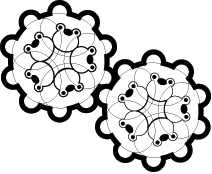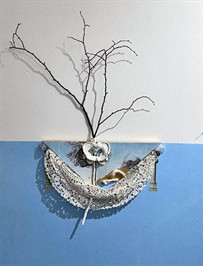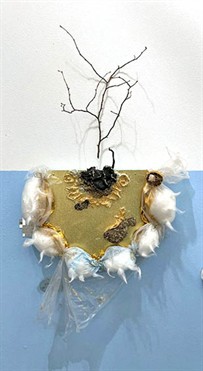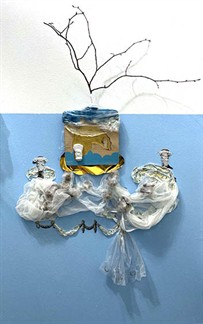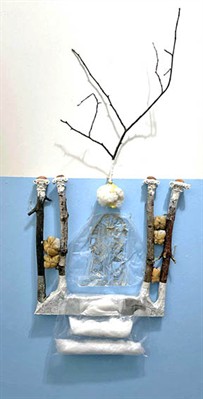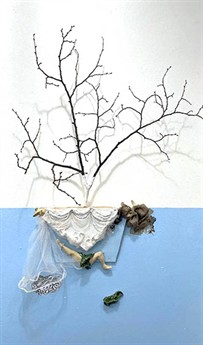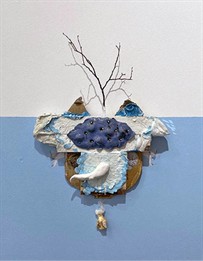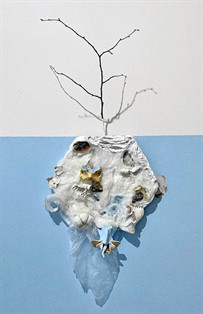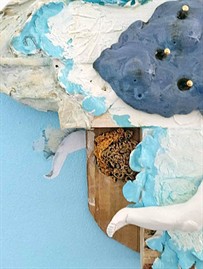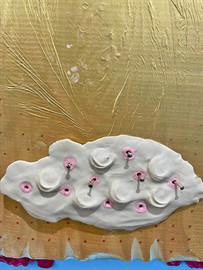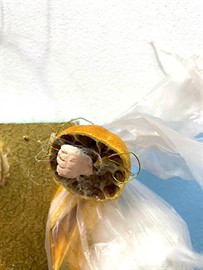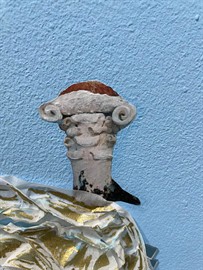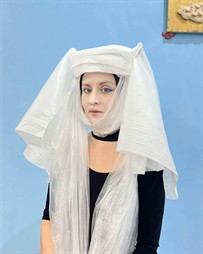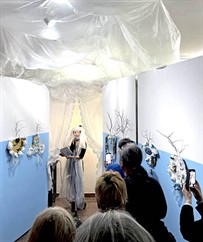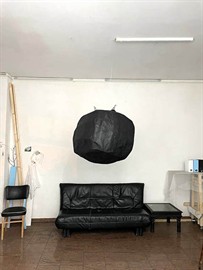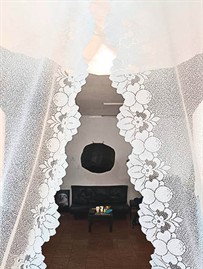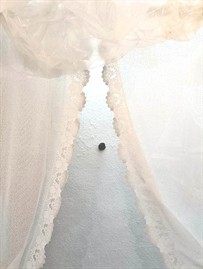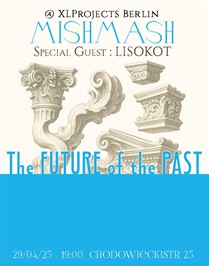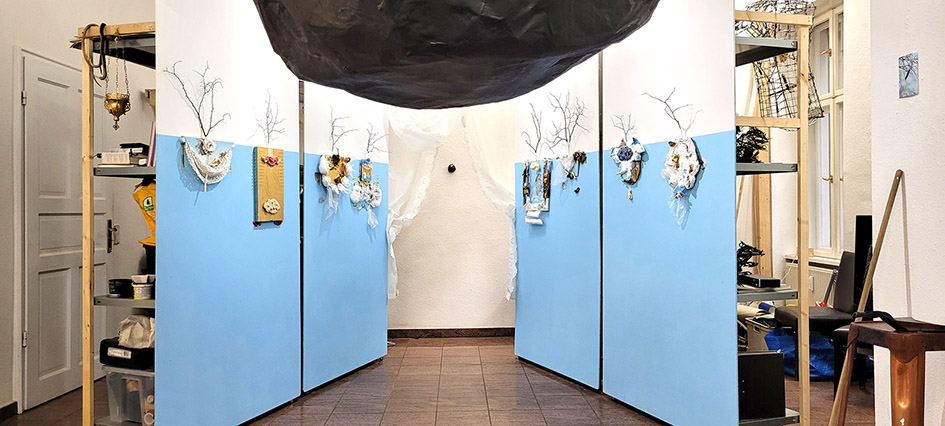The FUTURE of the PAST/ БУДУЩЕЕ ПРОШЛОГО
How to use baroque to describe what is happening now, or how to describe what is happening now, and get baroque?
We live in a time when language flickers, words change their meaning on the fly. At the same time, the formation of language - the selection of a language from a language group - what is this if not the ordering of accumulated errors? The world today is trying to give form to scraps of memories of old ideas. An architectural order is also a language system. We collect strange details in the form of order elements, a broken and reinvented language, where one replaces another, because it seems that speech can no longer be trusted and can only be felt. Therefore, it was not possible to write a text for the exhibition. Everything is too shaky. But you can watch it. You can listen.
Lisokot has composed a baroque epigram in homage to the echinus - an architectural element inspired by the sea urchin. She will bring it to life with a live performance at the opening.
Actualy it's a trap. For us and for you. The more you try to avoid narrative the more you produce it.
So, here is the Trap#1:
Beauty transforms everything into a slick, impenetrable surface.
When drama is shaped into art, especially visual art, it loses its weight and urgency. As Umberto Eco noted about the grotesque monsters on Romanesque and Gothic cathedrals, horror itself becomes ornamental. This is why we distrust direct political art - the aesthetic wraps even brutality in quotation marks. Our exhibition is made from repulsive and unpleasant materials, it appears cute and charming to the viewer. This is the unavoidable "magical" effect of visual art. The same happens with revived idealistic ideologies: their bloody aspects become beautified over time, losing their true horror.
That's why we humans are so intoxicated by our own ideas - even when they're inconsistent. We simply enjoy the fact that we've assembled elements together, and somehow they're holding.
In a baroque manner, we divided the exhibition space with a boundary - it runs between the level of living nature, which couldn't care less about our human imaginary constructs, and the lower level, where we've been messing around, creating magnificent ugliness.
Hideoism - a term we came up with about ten years ago - is also baroque, just from the side.
Trap#2
""Bite from one side and you'll shrink, bite from the other and you'll grow," says the Dodo to Alice. "Ah, dear Dodo, but the mushroom is round! And you call yourself a mathematician: Well then, I'll just break off a piece from wherever I can reach."
And since the mushroom is round, "pure" ideas, in their absolute form, flip into their opposites. Violence for the sake of all that is good and violence for the sake of evil - in the end, it's still just violence.
This is a rupture, where the elements of opposition activate each other.
In the Baroque, the essence lies in folds. Light and shadow - the opposition of black and white - are born in the folds of the same fabric.
Trap#3
The eras preceding the Baroque - not only in art but in history as a whole - were times of rigid canons, clear-cut answers to questions about the structure of the world and society, eras lacking scientific or critical approaches to perceiving reality. In architecture, classical forms for centuries, through the Greco-Roman order, depicted the structure of a building without actually reflecting its true construction. The multi-story columns on the facade of a palace were usually decorative, intended to create a grand, majestic image. The Corinthian capital of the Renaissance or Classicism, adorned with acanthus leaves, no longer conveyed the meaning it once held in Ancient Greece, when such details were brightly painted.
Baroque, by contrast, introduced a new, ironic approach to form, one that questioned previous canons. Just as science, emerging at the same time, began to critically and rationally analyze reality, Baroque culture took a critical stance toward form, order, and canon, bending and reshaping the substance of stone. It was a kind of intellectual mischief. It turned out that clear-cut answers were not truths, but merely forms of delusion. And the curving, fluid forms of the Baroque are closer to reality - just as science is closer to reality than mythology. It's emraced our strangeness and controversy.
Как использовать барокко, чтобы описать то, что происходит сейчас, или как описать происходящее сейчас, и в итоге прийти к барокко?
Мы живём во времена, когда язык мерцает, слова на лету меняют значение. В то же время формирование языка - выделение одного языка из языковой группы - что это, как не упорядочивание накопленных ошибок? Сегодняшний мир пытается придать форму обрывкам воспоминаний о старых идеях. Архитектурный ордер - это тоже языковая система. Мы собираем странные, даже отталкивающие детали в виде элементов ордера. Это сломанный и заново изобретённый язык, где одно заменяет другое, потому что кажется, что речи уже нельзя доверять. Поэтому текст к выставке написать не удалось. Всё слишком неустойчиво. Но это можно смотреть. Это можно слушать.
Лисокот сочинила барочную эпиграмму в честь эхина - архитектурного элемента, вдохновлённого морским ёжом. Она оживит её своим выступлением на открытии выставки.
На самом деле это ловушка. Для нас и для вас. Чем больше вы стараетесь избежать нарратива, тем больше его создаёте.
Итак, Ловушка ?1:
Красота превращает всё в гладкую, непроницаемую поверхность.
Когда драма превращается в искусство, особенно в визуальное, она теряет свой вес и остроту. Как писал Умберто Эко о гротескных чудовищах на романских и готических соборах - ужас становится орнаментом. Поэтому мы не доверяем прямому политическому искусству - эстетика ставит даже жестокость в кавычки. Наша выставка сделана из отталкивающих элементов и неприятных материалов - костей, жевачки, древесных грибов, соединенных с благородными - керамикой, кружевом, золотом. Но зрителю она кажется милой и обаятельной. Это неизбежный <магический> эффект визуального искусства. То же самое происходит с ожившими идеалистическими идеологиями: их кровавые аспекты со временем приукрашиваются и теряют свой подлинный ужас.
Поэтому мы люди так упиваемся своими идеями, даже если они непоследовательны, но нам нравится просто, то что мы собрали воедино элементы и они как то между собой держатся.
По барочному мы разделили экспозиционное поле границей - она проходит между уровнем живой природы - которой совершенно наплевать на наши человеческие воображаемые надстройки. И нижний уровень, где мы оттопыривались создавая великолепное уродство. Хидеоизм - термин который родился у нас лет 10 назад, это тоже барокко только сбоку.
Ловушка ?2
<Откусишь с одной стороны - уменьшишься, откусишь с другой - вырастешь>, - говорит Додо Алисе.
<Эх, Додоша, но гриб то круглый! А еще математик: Ну тогда я просто отломлю там, куда дотянусь>.
И поскольку гриб круглый, <чистые> идеи в своей абсолютной форме превращаются в противоположности. Насилие во имя добра и насилие во имя зла - в конце концов, это всё равно насилие.
Это - разлом, в котором элементы противоположности активируют друг друга.
В барокко суть кроется в складках. Свет и тень - противоположность чёрного и белого - рождаются в складках одной и той же ткани.
Ловушка ?3
Эпохи, предшествующие барокко - не только в искусстве, но и в истории в целом - были временами жёстких канонов, однозначных ответов на вопросы о структуре мира и общества. В архитектуре классические формы веками с помощью греко-римского ордера изображали структуру здания, не отражая его настоящего устройства. Многоярусные колонны на фасаде дворца обычно были декоративными, создавая образ величия и торжественности. Коринфская капитель эпохи Ренессанса или классицизма, украшенная листьями аканта, уже не несла того смысла, который имела в Древней Греции, когда такие детали были ярко раскрашены.
Барокко, напротив, ввело новый, ироничный подход к форме, ставящий под сомнение прежние каноны. Так же, как наука, зарождавшаяся в то же время, начала критически и рационально анализировать реальность, барочная культура заняла критическую позицию по отношению к форме, порядку и канону - изгибая и переосмысляя субстанцию камня. Это было своего рода интеллектуальное хулиганство.
Выяснилось, что чёткие ответы - не истина, а лишь форма заблуждения. И что изогнутые, текучие формы барокко ближе к реальности - так же, как наука ближе к реальности, чем мифология. Барокко приняло нашу странность и противоречивость.
We live in a time when language flickers, words change their meaning on the fly. At the same time, the formation of language - the selection of a language from a language group - what is this if not the ordering of accumulated errors? The world today is trying to give form to scraps of memories of old ideas. An architectural order is also a language system. We collect strange details in the form of order elements, a broken and reinvented language, where one replaces another, because it seems that speech can no longer be trusted and can only be felt. Therefore, it was not possible to write a text for the exhibition. Everything is too shaky. But you can watch it. You can listen.
Lisokot has composed a baroque epigram in homage to the echinus - an architectural element inspired by the sea urchin. She will bring it to life with a live performance at the opening.
Actualy it's a trap. For us and for you. The more you try to avoid narrative the more you produce it.
So, here is the Trap#1:
Beauty transforms everything into a slick, impenetrable surface.
When drama is shaped into art, especially visual art, it loses its weight and urgency. As Umberto Eco noted about the grotesque monsters on Romanesque and Gothic cathedrals, horror itself becomes ornamental. This is why we distrust direct political art - the aesthetic wraps even brutality in quotation marks. Our exhibition is made from repulsive and unpleasant materials, it appears cute and charming to the viewer. This is the unavoidable "magical" effect of visual art. The same happens with revived idealistic ideologies: their bloody aspects become beautified over time, losing their true horror.
That's why we humans are so intoxicated by our own ideas - even when they're inconsistent. We simply enjoy the fact that we've assembled elements together, and somehow they're holding.
In a baroque manner, we divided the exhibition space with a boundary - it runs between the level of living nature, which couldn't care less about our human imaginary constructs, and the lower level, where we've been messing around, creating magnificent ugliness.
Hideoism - a term we came up with about ten years ago - is also baroque, just from the side.
Trap#2
""Bite from one side and you'll shrink, bite from the other and you'll grow," says the Dodo to Alice. "Ah, dear Dodo, but the mushroom is round! And you call yourself a mathematician: Well then, I'll just break off a piece from wherever I can reach."
And since the mushroom is round, "pure" ideas, in their absolute form, flip into their opposites. Violence for the sake of all that is good and violence for the sake of evil - in the end, it's still just violence.
This is a rupture, where the elements of opposition activate each other.
In the Baroque, the essence lies in folds. Light and shadow - the opposition of black and white - are born in the folds of the same fabric.
Trap#3
The eras preceding the Baroque - not only in art but in history as a whole - were times of rigid canons, clear-cut answers to questions about the structure of the world and society, eras lacking scientific or critical approaches to perceiving reality. In architecture, classical forms for centuries, through the Greco-Roman order, depicted the structure of a building without actually reflecting its true construction. The multi-story columns on the facade of a palace were usually decorative, intended to create a grand, majestic image. The Corinthian capital of the Renaissance or Classicism, adorned with acanthus leaves, no longer conveyed the meaning it once held in Ancient Greece, when such details were brightly painted.
Baroque, by contrast, introduced a new, ironic approach to form, one that questioned previous canons. Just as science, emerging at the same time, began to critically and rationally analyze reality, Baroque culture took a critical stance toward form, order, and canon, bending and reshaping the substance of stone. It was a kind of intellectual mischief. It turned out that clear-cut answers were not truths, but merely forms of delusion. And the curving, fluid forms of the Baroque are closer to reality - just as science is closer to reality than mythology. It's emraced our strangeness and controversy.
Как использовать барокко, чтобы описать то, что происходит сейчас, или как описать происходящее сейчас, и в итоге прийти к барокко?
Мы живём во времена, когда язык мерцает, слова на лету меняют значение. В то же время формирование языка - выделение одного языка из языковой группы - что это, как не упорядочивание накопленных ошибок? Сегодняшний мир пытается придать форму обрывкам воспоминаний о старых идеях. Архитектурный ордер - это тоже языковая система. Мы собираем странные, даже отталкивающие детали в виде элементов ордера. Это сломанный и заново изобретённый язык, где одно заменяет другое, потому что кажется, что речи уже нельзя доверять. Поэтому текст к выставке написать не удалось. Всё слишком неустойчиво. Но это можно смотреть. Это можно слушать.
Лисокот сочинила барочную эпиграмму в честь эхина - архитектурного элемента, вдохновлённого морским ёжом. Она оживит её своим выступлением на открытии выставки.
На самом деле это ловушка. Для нас и для вас. Чем больше вы стараетесь избежать нарратива, тем больше его создаёте.
Итак, Ловушка ?1:
Красота превращает всё в гладкую, непроницаемую поверхность.
Когда драма превращается в искусство, особенно в визуальное, она теряет свой вес и остроту. Как писал Умберто Эко о гротескных чудовищах на романских и готических соборах - ужас становится орнаментом. Поэтому мы не доверяем прямому политическому искусству - эстетика ставит даже жестокость в кавычки. Наша выставка сделана из отталкивающих элементов и неприятных материалов - костей, жевачки, древесных грибов, соединенных с благородными - керамикой, кружевом, золотом. Но зрителю она кажется милой и обаятельной. Это неизбежный <магический> эффект визуального искусства. То же самое происходит с ожившими идеалистическими идеологиями: их кровавые аспекты со временем приукрашиваются и теряют свой подлинный ужас.
Поэтому мы люди так упиваемся своими идеями, даже если они непоследовательны, но нам нравится просто, то что мы собрали воедино элементы и они как то между собой держатся.
По барочному мы разделили экспозиционное поле границей - она проходит между уровнем живой природы - которой совершенно наплевать на наши человеческие воображаемые надстройки. И нижний уровень, где мы оттопыривались создавая великолепное уродство. Хидеоизм - термин который родился у нас лет 10 назад, это тоже барокко только сбоку.
Ловушка ?2
<Откусишь с одной стороны - уменьшишься, откусишь с другой - вырастешь>, - говорит Додо Алисе.
<Эх, Додоша, но гриб то круглый! А еще математик: Ну тогда я просто отломлю там, куда дотянусь>.
И поскольку гриб круглый, <чистые> идеи в своей абсолютной форме превращаются в противоположности. Насилие во имя добра и насилие во имя зла - в конце концов, это всё равно насилие.
Это - разлом, в котором элементы противоположности активируют друг друга.
В барокко суть кроется в складках. Свет и тень - противоположность чёрного и белого - рождаются в складках одной и той же ткани.
Ловушка ?3
Эпохи, предшествующие барокко - не только в искусстве, но и в истории в целом - были временами жёстких канонов, однозначных ответов на вопросы о структуре мира и общества. В архитектуре классические формы веками с помощью греко-римского ордера изображали структуру здания, не отражая его настоящего устройства. Многоярусные колонны на фасаде дворца обычно были декоративными, создавая образ величия и торжественности. Коринфская капитель эпохи Ренессанса или классицизма, украшенная листьями аканта, уже не несла того смысла, который имела в Древней Греции, когда такие детали были ярко раскрашены.
Барокко, напротив, ввело новый, ироничный подход к форме, ставящий под сомнение прежние каноны. Так же, как наука, зарождавшаяся в то же время, начала критически и рационально анализировать реальность, барочная культура заняла критическую позицию по отношению к форме, порядку и канону - изгибая и переосмысляя субстанцию камня. Это было своего рода интеллектуальное хулиганство.
Выяснилось, что чёткие ответы - не истина, а лишь форма заблуждения. И что изогнутые, текучие формы барокко ближе к реальности - так же, как наука ближе к реальности, чем мифология. Барокко приняло нашу странность и противоречивость.
Installation.
XLProjects Berlin
2025
XLProjects Berlin
2025
Video of Installation
with a vocal performance by Lisokot,
who wrote a baroque epigrame specialy
for this occasion.
XLProjects Berlin
2025
with a vocal performance by Lisokot,
who wrote a baroque epigrame specialy
for this occasion.
XLProjects Berlin
2025
Photos by MishMash, V.Dudchenko, S.Khripun
